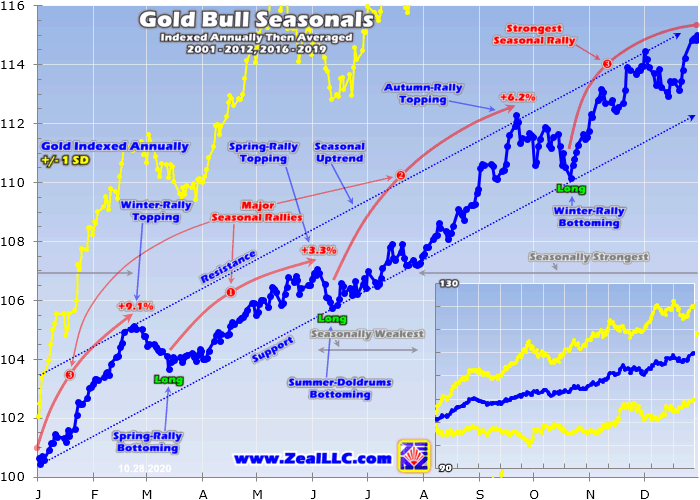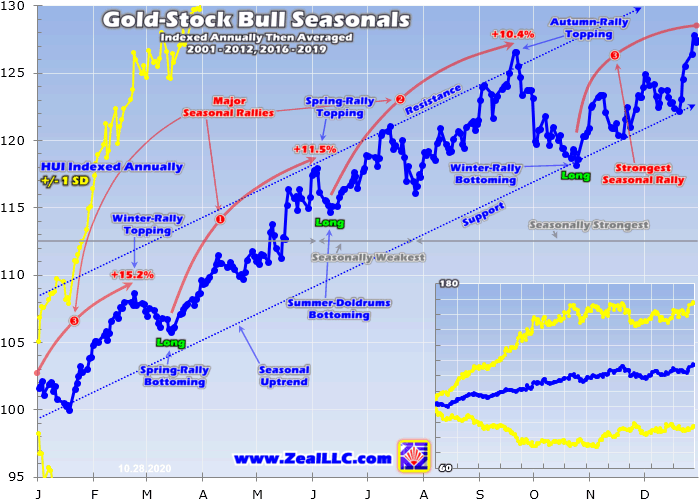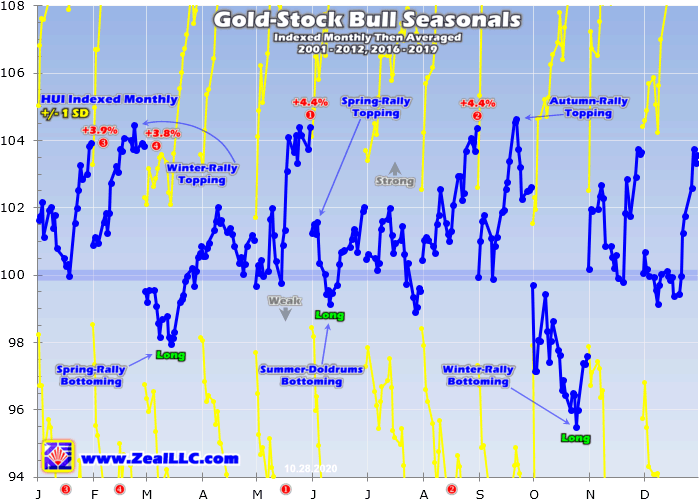
The gold miners’ stocks have mostly been correcting in recent months, after blasting higher with gold last summer. While this necessary and healthy selloff to rebalance sentiment likely isn’t over yet, this sector is entering its strongest seasonal rally of the year. That portends big gains in coming months as the next bull-market uplegs in gold and its miners’ stocks get underway. These seasonal tailwinds amplify upside.
Seasonality is the tendency for prices to exhibit recurring patterns at certain times during the calendar year. While seasonality doesn’t drive price action, it quantifies annually-repeating behavior driven by sentiment, technicals, and fundamentals. We humans are creatures of habit and herd, which naturally colors our trading decisions. The calendar year’s passage affects the timing and intensity of buying and selling.
Gold stocks exhibit strong seasonality because their price action mirrors that of their dominant primary driver, gold. Gold’s seasonality generally isn’t driven by supply fluctuations like grown commodities see, as its mined supply remains relatively steady year-round. Instead gold’s major seasonality is demand-driven, with global investment demand varying considerably depending on the time in the calendar year.
This gold seasonality is fueled by well-known income-cycle and cultural drivers of outsized gold demand from around the world. And the biggest seasonal surge of all is just getting underway heading into winter. As the Indian-wedding-season gold-jewelry buying that normally drives this metal’s big autumn rally winds down, the Western holiday season ramps up. The holiday spirit puts everyone in the mood to spend money.
Men splurge on vast amounts of gold jewelry for Christmas gifts for their wives, girlfriends, daughters, and mothers. The holidays are also a major engagement season, with Christmas Eve and New Year’s Eve being two of the biggest proposal nights of the year. Between a third to a half of the entire annual sales of jewelry retailers come in November and December! And jewelry historically dominates overall gold demand.
According to the World Gold Council, from 2015 to 2019 jewelry demand averaged 51% of gold’s overall global demand! That’s much larger than gold investment demand’s 29% share. And in this crazy 2020 dominated by the COVID-19 pandemic, holiday gold-jewelry buying could prove even bigger than normal. After cratering earlier this year during governments’ draconian national lockdowns, big catch-up buying is due.
The WGC publishes the best-available world gold fundamental data quarterly, and the latest report as I pen this essay is Q2’20’s. During the first half of this year, global gold-jewelry demand plummeted an astounding 46% year-over-year! That was wildly unprecedented, largely driven by pandemic mitigation measures in the jewelry-demand powerhouses of China and India. But as lockdowns pass, gold buying is normalizing.
From 2015 to 2019, fully a third of global jewelry demand came from China. In Q1’20 which proved the height of that country’s stay-at-home orders and general COVID-19 fear, jewelry demand collapsed 66% YoY. But in Q2’20 as the Chinese government lifted restrictions and claimed the virus was under control, jewelry demand improved considerably falling 36% YoY. The Chinese are resuming buying as normal life returns.
But the big holiday-season gold-jewelry splurge is more of a Western thing. Because of this pandemic, American gold-jewelry demand could explode in Q4’20 for a couple reasons. With the great majority of people spending far less on services including travel due to COVID-19 worries, sales of goods have been soaring. While a lot of Americans are struggling, plenty aren’t. So analysts expect a big Christmas season.
And learning to live with COVID-19 and governments’ heavy-handed responses to it has made 2020 the most stressful year of our lifetimes. Marriages have been under serious strain with work and school being shoehorned into homes and stress-relieving vacations cancelled. So legions of husbands are likely to buy their frazzled wives impressive gold jewelry this year. That holiday demand could prove exceptional.
The usual frenzied Western jewelry buying heading into Christmas shifts to pure investment demand after year-end. That’s when Western investors figure out how much surplus income they earned during the prior year after bonuses and taxes. Some of this is plowed into gold in January, driving it higher. Finally the big winter gold rally climaxes in late February on major Chinese New Year gold buying flaring up in Asia.
So during its bull-market years, gold has always tended to enjoy major winter rallies driven by these sequential episodes of outsized demand. Naturally the gold stocks follow gold higher, amplifying its gains due to their great profits leverage to the gold price. Today gold stocks are now once again heading into their strongest seasonal rally of the year, driven by this annually-recurring robust winter gold demand.
Since it is gold’s own demand-driven seasonality that fuels gold stocks’ seasonality, that’s logically the best place to start to understand what’s likely coming. Price action is very different between bull and bear years, and gold remains in a middle-aged bull market. After falling to a 6.1-year secular low in mid-December 2015 as the Fed kicked off its last rate-hike cycle, gold powered 29.9% higher over the next 6.7 months.
Crossing the +20% threshold in March 2016 confirmed a new bull market was underway. Gold corrected after that sharp initial upleg, but normal healthy selling was greatly exacerbated after Trump’s surprise election win. Investors fled gold to chase the taxphoria stock-market surge. Gold’s correction cascaded to serious proportions, hitting -17.3% in mid-December 2016. But that remained shy of a new bear’s -20%.
Gold rebounded sharply from those severe-correction lows, nearly fully recovering by early September 2017. But gold failed to break out to new bull-market highs, then and several times after. That left gold’s bull increasingly doubted, until June 2019. Then gold surged to a major decisive breakout confirming its bull remained alive and well! Its total gains grew to 96.2% over 4.6 years by early August 2020, still modest.
Gold’s last mighty bull market ran from April 2001 to August 2011, where it soared 638.2% higher! And while gold consolidated high in 2012, that was technically a bull year too since gold just slid 18.8% at worst from its bull-market peak. Gold didn’t enter formal bear-market territory until April 2013, thanks to the crazy stock-market levitation driven by extreme distortions from the Fed’s QE3 bond monetizations.
So the bull-market years for gold in modern history ran from 2001 to 2012, skipped the intervening bear-market years of 2013 to 2015, then resumed in 2016 to 2020. Thus these are the years most relevant to understanding gold’s typical seasonal performance throughout the calendar year. We’re interested in bull-market seasonality, because gold remains in its latest bull today and bear-market action is quite dissimilar.
Prevailing gold prices varied radically through these modern bull years, running between $257 when gold’s last secular bull was born to early August’s newest record high of $2062. All those long years with that great range of gold levels have to first be rendered in like-percentage terms in order to make them perfectly comparable. Only then can they be averaged together to distill out gold’s bull-market seasonality.
That’s accomplished by individually indexing each calendar year’s gold price action to its final close of the preceding year, which is recast at 100. Then all gold price action of the following year is calculated off that common indexed baseline, normalizing all years regardless of price levels. So gold trading at an indexed level of 105 simply means it has rallied 5% from the prior year’s close, while 95 shows it’s down 5%.
This chart averages the individually-indexed full-year gold performances in those bull-market years from 2001 to 2012 and 2016 to 2019. 2020 isn’t included yet since it remains a work in progress. This bull-market-seasonality methodology reveals that gold’s strongest seasonal rally by far is its winter one which tends to start in late October. That portends big gains in coming months from correction-depressed gold stocks.

During these modern bull-market years, gold has enjoyed a strong and pronounced seasonal uptrend. From that prior-year-final-close 100 baseline, it has powered 15.0% higher on average by year-ends! These are major gains by any standard, especially averaged across 16 different years. The majority of these annual seasonal gains accrue during gold’s big winter rally, which tends to start in late October.
On average gold’s biggest seasonal selloff of the year following its autumn rally topping tends to bottom on that month’s 16th trading day. That happened to be October 22nd this year. From there gold surges 9.1% higher on average by late February. That big winter rally dwarfs the spring and autumn seasonal rallies which have averaged 3.3% and 6.2% gains. This winter-rally span is the best time to be long gold!
But seasonality comes with an important caveat, it can’t override gold’s primary drivers of sentiment, technicals, and fundamentals. They are the engines moving gold prices, while seasonals act more like prevailing winds boosting or hindering wherever gold is heading under its main locomotion. So this year’s strong winter-rally season could start later than normal after gold’s underway correction runs its course.
Gold shot parabolic last summer on extreme differential gold-ETF-share demand, which went missing in action after gold peaked losing its greed-stoking upside momentum. That left this metal extraordinarily overbought, necessitating a healthy correction to rebalance away euphoric sentiment and normalize super-stretched technicals. Exacerbating gold’s downside risk was a very-low US dollar, which needed to bounce.
A rapidly-strengthening US dollar unleashes major gold-futures selling by leveraged speculators. The resulting falling gold prices scare gold-ETF shareholders into dumping their own positions, amplifying the correction. With gold remaining well above its 200-day moving average which is major correction support, this process might not be over yet. So gold’s winter rally could be delayed until this rebalancing selloff ends.
That would compress gold’s winter rally into the later months of this span. On average in these modern gold-bull years of 2001 to 2012 and 2016 to 2019, gold has tended to climb 2.4% in Novembers, 1.1% in Decembers, 3.1% in Januaries, and 1.7% in Februaries. So even if these peak seasonal tailwinds are delayed a few weeks until gold’s correction finishes its important work, there’s still plenty of time for the winter rally.
Naturally the gold miners’ own seasonality is directly driven by gold’s. The leading gold-stock benchmark and trading vehicle is the GDX VanEck Vectors Gold Miners ETF. It tends to amplify material gold-price moves by 2x to 3x. If gold’s own winter rally sees a delayed start this year due to that healthy correction, so will the gold stocks’ winter rally. But they are still likely to see major gains compacted into a shorter time frame.
This next chart applies this same modern-gold-bull-year seasonality methodology to gold stocks. Since GDX was born later in May 2006, its price history is insufficient for longer-term studies. Thus the classic HUI gold-stock index is used instead. GDX and the HUI closely track each other, they are functionally interchangeable containing most of the same major gold stocks. Gold gains drive their big winter rally.

During these same modern gold-bull-market years of 2001 to 2012 and 2016 to 2019, the gold stocks as measured by the HUI enjoyed average gains of 15.2% between late October to late February. That also makes the gold stocks’ winter rally their largest seasonal one of the year, besting both the spring rally’s 11.5% gain and autumn rally’s 10.4% upside. Winter also sees gold stocks’ strongest cluster of monthly rallies.
The monthly performances underlying these calendar-year seasonals are easier to understand if gold-stock seasonality is instead sliced into months. This next chart does just that, offering a more-granular perspective on seasonality. Each calendar month in these same modern bull-market years is individually indexed to 100 as of the previous month’s final close, then all like-months’ indexes are averaged together.

The major gold stocks have averaged impressive 3.7%, 3.6%, 3.9%, and 3.8% gains in Novembers, Decembers, Januaries, and Februaries! The latter couple months climaxing their strong winter rally rank as the 3rd and 4th best months of the year seasonally. So there is no more important time to be heavily long the gold miners. Even if the gold correction delays and compresses this winter rally, big gains are coming.
Gold stocks will naturally rally with the metal that overwhelmingly drives their profits when gold’s next bull-market upleg gets underway. Gold-stock corrections and uplegs mirror and amplify gold’s own, running parallel to them at an exaggerated scale. So whenever gold gets sufficiently oversold forcing sentiment to bearish-enough levels to wrap up this correction, gold stocks will bottom in sympathy. That’s when to buy big!
But it’s the gold miners’ wildly-bullish fundamentals that could supercharge their coming winter rally. The record prevailing gold prices this year have blasted gold-stock profits stratospheric, with earnings growth likely to continue soaring. When strong seasonal tailwinds line up with bullish sentiment, technicals, and fundamentals, seasonal rallies balloon to outsized proportions. That makes coming months’ potential huge.
The gold miners are currently reporting their Q3’20 operational and financial results, which are due by mid-November. They should collectively reveal epic profits growth, justifying far-higher gold-stock prices during gold’s next bull upleg. Right after every quarterly earnings season, I do a deep fundamental dive into how the major gold miners of GDX are faring as a whole. Their collective Q3 results should prove awesome.
Gold-mining profitability is driven by prevailing gold prices less all-in sustaining costs for producing that metal. Thanks to gold’s parabolic upleg peaking in early August, last quarter gold averaged an all-time-record high $1912. That soared 29.8% YoY from Q3’19’s levels! Gold-stock prices are highly leveraged to gold because the miners’ costs are largely fixed. They don’t change much regardless of prevailing gold prices.
Quarter after quarter individual gold mines generally require the same levels of infrastructure, equipment, and employees to feed their fixed-capacity mills with fresh gold-bearing ores. Thus higher gold prices like Q3’s usually directly translate into much-higher earnings. Over the past four reported quarters ending in Q2’20, the GDX major gold miners’ all-in sustaining costs averaged $933 per ounce. Q3’s will likely be lower.
In Q2’20 which was the peak quarter for national lockdowns to fight COVID-19, plenty of gold miners were forced to temporarily suspend operations. The resulting lower output left fewer ounces to spread the big fixed costs of gold mining across, catapulting GDX miners’ AISCs to $984. But with gold mines reopening in late Q2 and early Q3, and miners rushing to make up for lost ounces, Q3 should see lower unit costs.
But even if the past year’s $933 average holds, gold-mining earnings are soaring. Last quarter’s lofty $1912 average gold prices less conservative $933 AISCs imply the major gold miners earned a colossal $979 per ounce wresting their product from the bowels of the earth. That would make for stupendous stock-market-leading 66% year-over-year profits growth from Q3’19! And this isn’t some one-off anomaly.
During the last four reported quarters ending in Q2’20, the major gold miners of GDX saw their collective earnings soar 54%, 56%, 56%, and 66% YoY! That’s the big fundamental reason gold-stock prices have rocketed in 2019 and 2020. And with gold’s own bull market likely to keep marching higher on balance for years to come for all kinds of reasons, higher gold prices will continue to fuel outsized gold-miner profits growth.
So there’s a good chance gold stocks’ coming winter rally will be amplified as speculators and investors increasingly discover and marvel at the epic earnings numbers this sector is putting up. Seeing seasonal tailwinds aligning with sentiment, technicals, and fundamentals undergirds the strongest seasonal rallies. So once gold’s necessary correction runs its course, the gold-stock outlook remains incredibly bullish.
Gold-miner valuations remain really low relative to gold, so this sector has lots of lost ground to regain in coming years. And some of that is likely over the next four months which are gold stocks’ seasonally-strongest span of the year. So once gold’s own indicators flash green lights implying its correction is over, traders should aggressively add fundamentally-superior gold miners to ride this sector’s big winter rally.
At Zeal we started aggressively buying and recommending fundamentally-superior gold and silver miners in our weekly and monthly subscription newsletters back in mid-March right after the stock-panic lows. We layered into dozens of new positions before gold stocks grew too overbought, which were stopped out later at huge realized gains running as high as +199%! Our subscribers multiplied their wealth within months.
To profitably trade high-potential gold stocks, you need to stay informed about their technicals, sentiment, and fundamentals. And what is moving gold, their dominant primary driver. Our popular newsletters are a great way. They draw on my vast experience, knowledge, wisdom, and ongoing research to explain what’s going on in the markets, why, and how to trade them with specific stocks. Subscribe today and take advantage of our 20%-off sale! Corrections are the time to do your gold-stock homework, preparing to redeploy as they pass.
The bottom line is gold stocks are just entering their seasonally-strongest period of the year. Their big winter rally is fueled by gold’s own, which is driven first by outsized demand from holiday jewelry buying and later new-year investment buying. So both the metal and its miners’ stocks have strong tendencies to rally between late October to late February in bull-market years. It’s the best calendar span to own gold stocks!
This year’s dawning winter rally has great upside potential after the gold and gold-stock corrections run their courses. The gold miners’ fundamentals remain powerfully bullish, with earnings soaring on higher prevailing gold prices. The resulting low gold-stock valuations should attract lots of new investors to this contrarian sector as Q3’s spectacular results capture their attention. Seasonal tailwinds will amplify that upside.
(By Adam Hamilton)